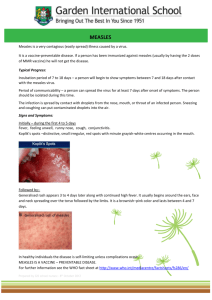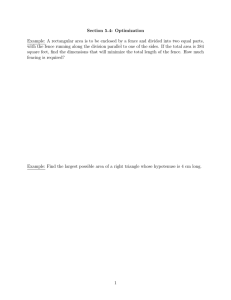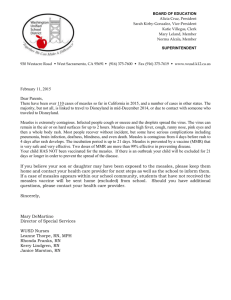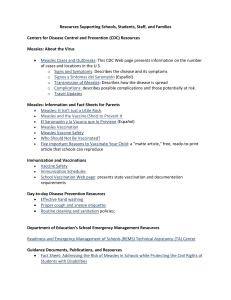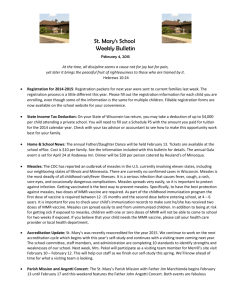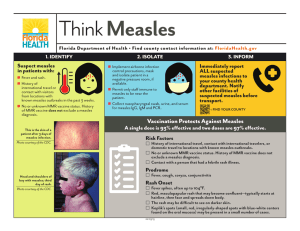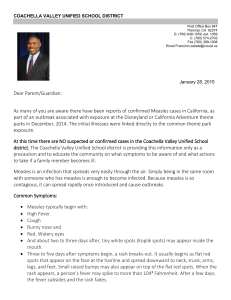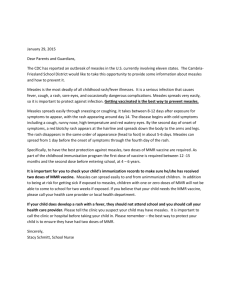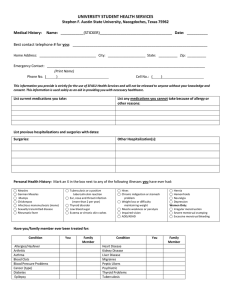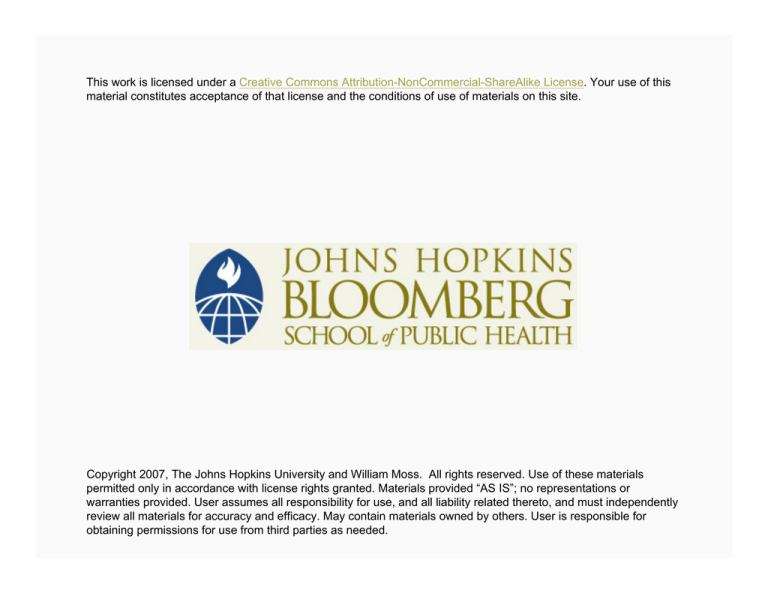
This work is licensed under a Creative Commons Attribution-NonCommercial-ShareAlike License. Your use of this
material constitutes acceptance of that license and the conditions of use of materials on this site.
Copyright 2007, The Johns Hopkins University and William Moss. All rights reserved. Use of these materials
permitted only in accordance with license rights granted. Materials provided “AS IS”; no representations or
warranties provided. User assumes all responsibility for use, and all liability related thereto, and must independently
review all materials for accuracy and efficacy. May contain materials owned by others. User is responsible for
obtaining permissions for use from third parties as needed.
Measles
William Moss, MD, MPH
Johns Hopkins University
Objectives
Different goals of measles control
Virologic and clinical aspects of measles
Basic epidemiology of measles virus
Strategies for control
Obstacles to control
Eradication
3
Goals
Measles control
− Reduce measles mortality
− Reduce measles incidence (number of cases)
Measles elimination
− Stop indigenous transmission in a region
Measles eradication
− Stop global transmission
4
What Do We Need to Know About?
Measles and measles virus
The epidemiology of measles
Measles control strategies
Measles control programs
Obstacles to measles control
5
Section A
Background
Measles Virus
Family: Paramyxoviridae
− Genus: Morbillivirus
Sensitive to UV light and heat
Antigenically stable
Major proteins
− Hemagglutinin (H): receptor binding protein
− Fusion (F): membrane fusion and virus entry
− Nucleoprotein (N): most variable genetically
7
Measles Virus Budding from Cell
8
Phylogenetic Tree
9
Clinical Features of Measles
Source: adapted by CTLT from Krugman, S., Katz, S. L., Gershon, A. A., and Wilfert,
C. M. (Eds.). (1992). Infectious diseases of children (9th ed.) St. Louis: Mosby.
10
Measles Rash
Source: CDC PHIL
11
Measles Conjunctivitis and Coryza
12
Complications of Measles Virus
Equivalent of the rash on other
epithelial surfaces produced:
•
•
•
•
•
Conjuctivitis
Sore mouth
Laryngitis
Bronchopneumonia
Enteritis, diarrhea
The possible association between the severity
of measles rash and the manifestation of the
disease in epithelial surfaces
External
rash:
Normal rash
develops
Rash darkens
to a deep red
and violet color
Desquamation
(amount depends
on the extent of
the rash’s darkening)
13
Example of Desquamating Rash
Photo Source: William Moss
14
Measles Case Fatality Ratio
15
Immune Responses
Life-long immunologic protection
Antibody responses
− IgM
− IgG
Cellular immune responses
Immune suppression
16
Antibody Response to Acute Measles Infection
17
Clinical, Virologic, and Immunologic Characteristics
18
Immune Suppression
T Cell
T Cell
T Cell
↑ IL-10
Monocyte
DC
↓ IL-12
↓ Differentiation
Interleukin-12
Downregulation
Impaired Antigen
Presentation
↑ IL-4
Lymphocyte
Apoptosis
Impaired
Lymphoproliferation
Immunomodulatory
Cytokines
Source: Moss, W. J., Ota, M. O., and Griffin, D. E. (August 2004). Measles: Immune suppression and immune response. Int J
Biochem Biol, 36, 8, 1380–1385.
Top 10 Causes of Death in Under Fives Worldwide, 2000
Source: WHO Global Burden of Diseases 2000
20
Measles Cases Have Declined
Source: WHO vaccine-preventable disease monitoring system, 2005 global summary
21
Estimated Number of Deaths
Estimated Worldwide Measles-Related Deaths
873,000
740,000
676,000
594,000
530,000
Target*
for 2005
1999
2000
2001
Year
2002
2003
*In 2002 the World Health Assembly urged member countries to
halve measles death by 2005, compared with 1999 estimates.
Adapted by CTLT from: (2005). Weekly Epidemiological Record, 80, 80.
22
Counting Cases of Disease
23
What Is the Message?
Measles in the United States, 1950–2001
Source: CDC
24
What Is the Message?
25
Measles: Leading Vaccine-Preventable Cause of Death
Diphtheria
0%
Neonatal
tetanus
12%
Hib
23%
Pertussis
17%
Yellow fever
2%
Polio
0.1%
Measles
46%
Data Source: (2003). Journal of Infectious Diseases, 187(Suppl. 1), S15–S21.
26
Most Measles Deaths Occur in Sub-Saharan Africa
Estimated measles deaths by WHO region, 2000
500,000
400,000
300,000
200,000
100,000
0
AFRO
SEARO EMRO
Source: (2003). The Weekly Epidemiological Record, 21, 184–187.
WPRO
EURO
PAHO
27
Section B
Epidemiology
Measles Epidemiology
Transmission characteristics
Communicability
Disease distribution
− Person
− Place
− Time
29
Transmission Characteristics
Routes of transmission
− Respiratory droplet, airborne and direct contact
Humans only reservoir
− Monkeys infected, do not sustain transmission
Incubation period
− Ten days to fever, 14 days to rash
Infectious period
− From five days before rash until four days after rash
30
Communicability
Highly contagious
− 80% of susceptible household contacts
Outbreaks with only 3–7% susceptibles
Chains of transmission
− School children, household contacts, health care workers
(HCW)
− ? transmission from subclinical measles
31
Disease Distribution
Person
− Age distribution
Place
− Population density to maintain transmission
− Urban vs. rural
Time
− Seasonality
− Epidemic cycles
32
Age Distribution
Depends on . . .
− Rate of loss of maternal antibody
− Rate of contact with infected persons
− Age at immunization
In developing countries with high population density and low
vaccination coverage, younger children are infected
33
Age Distribution of Measles Cases
Source: adapted by CTLT from Taylor et al. (1988); Koster et al. (1981).
34
Epidemic Cycles
Cyclic pattern of measles incidence
− Low vaccination coverage: 1–3 years
− High vaccination coverage: 5–7 years
Pattern largely due to accumulation and decline in the number
of susceptibles
− Population density and birth rate
− Migration patterns
− Vaccination coverage
35
Measles Outbreak Patterns
36
Section C
Measles Control and Elimination
Control Strategies
Case management
Measles vaccination
− Routine
− Enhanced
Surveillance
Outbreak response
38
Case Management
Vitamin A
− Reduced morbidity and mortality
− As therapy and preventive supplementation
− Recommended for all children with measles
− Two doses on two consecutive days
Antibiotics
− Treat if clinical signs of bacterial infection
− Little evidence to support prophylactic use
39
Vitamin A and Measles Mortality
Note: Measles case-fatality rates among hospitalized patients randomized to receive high-dose vitamin A (cod liver oil
in the London trial) compared with those of their controls. Vitamin A supplementation reduced mortality by ~50% in all
three trials. Adapted by CTLT from Al Sommer.
40
Measles Vaccines
Types of measles vaccines
− Inactivated
− Attenuated
− High-titer
41
Measles Vaccines
Types of measles vaccines
− Inactivated
− Attenuated
− High-titer
Immunization schedules
− 9 vs. 12 months
− Second dose
Stability and administration
− Relatively heat-stable in lyophilized form
− Loss of potency if stored above 8°C (cold chain)
− Parenteral administration
42
Immune Protection
Correlates of immune protection
− Anti-measles antibody titers
Determinants of response
− Age at vaccination
− Passively acquired maternal antibodies
− Immunologic immaturity
− Immune status
Duration of protection
− At least 20 years
− Less in immunocompromised children
43
Age of Vaccination
Decline in passive maternal antibody vs. rise in measles
incidence
− “Window of opportunity”
Proportion responding at different ages
− 85% at 9 months of age
− 90–95% at 12 months of age
− 95% who fail to respond to 1st dose will respond to 2nd
dose
44
Optimal Age of Vaccination
45
Vaccination Strategies
“ The build-up of susceptible children over time in a population is
the most serious obstacle to measles eradication.”
— PAHO* Measles Eradication Field Guide
*Pan American Health Organization
46
WHO Immunization Schedule
Age
Vaccines
Birth
BCG, OPV 0, HB 1
6 weeks
DTP 1, OPV 1, HB 2
10 weeks
DTP 2, OPV 2
14 weeks
DTP 3, OPV 3, HB 3
9 months
Measles, yellow fever
47
Population Immunity—One Dose
Percent Coverage
Percent Vaccine Efficacy
Percent Immune
80
95
76
90
95
86
95
95
90
95
90
86
95
80
81
48
Late Two-Dose Elimination Strategy
2nd dose: decrease susceptibles
− 1° vaccine failure
− Missed immunization
Routine immunization services
− Finland: two-dose schedule in 1982
− United States: 12–15 months and 4–6 years
Supplemental campaigns
− Rapidly reduce number of susceptibles below the epidemic
threshold
− Successful in polio eradication programs
49
Countries with Measles Mortality Reduction Strategies
50
Population Immunity—Two Doses
Coverage
85%
1st dose
95%
2nd dose
95%
2nd dose
85%
72%
83%
95%
90%
77%
88%
97%
95%
81%
93%
98%
100%
85%
98%
99%
51
Measles Elimination Strategies: PAHO
Catch up
Keep up
Follow up
Mop up
52
Catch Up
Goal: rapidly interrupt transmission
One-time-only vaccination campaign
Conducted during low transmission
Conducted over short time period
− One week to one month
Target wide age cohort of children
− PAHO: all children 9 months to 14 years of age
Community mobilization
53
Keep Up
Goal: > 90% coverage of birth cohort
Strategies to improve routine coverage
− Improve access to vaccination services
− Integrate with routine health services
− Tracking systems
− Outreach activities
− School-based programs
− Reduce missed opportunities
54
Follow Up
Prevent accumulation of susceptibles
− Measles vaccine not 100% effective
− Coverage not 100%
Conducted when the estimated number of susceptible children
= birth cohort
− Usually about every 3–5 years
Target children 1–4 years of age
55
Mop Up
Goal: intensive vaccination efforts to reach unvaccinated
children
Target wide age range
Target high-risk areas
− Low coverage
− Recent measles cases
− Poor surveillance
− Crowding, poverty, and migration
56
Mass Vaccination and Morbidity in Cuba, 1971–1996
Source: adapted by CTLT from the Cuban Ministry of Health.
57
Measles in Southern Africa, 1996–2000
Source: Biellik, R. (2002). Lancet, 359, 1564–1568.
58
Measles Ward
Photo source: William Moss.
59
Measles Surveillance in Southern Africa, 2000
Country
No. of
reported
cases
Investigated
Cases w/
specimens
taken
Specimens
taken, results
available
Measles
IgM pos.*
Measles
IgM neg.
Measles
IgM indeter.
Rubella IgM
pos.
Botswana
1666
678
(41%)
856 (126%)
210
(25%)
0
210
0
170
Lesotho
660
0
0
0
0
0
0
0
Malawi
303
303
(100%)
303
(100%)
287
(95%)
0
287
0
0
Namibia
261
261
(100%)
237
(91%)
173
(73%)
13
(8%)
158
2
43
South Africa
1449
1449
(100%)
1303
(90%)
1303
(100%)
77
(6%)
1166
9
471
Swaziland
230
230
(100%)
230
(100%)
229
(100%)
10
(4%)
219
0
115
Zimbabwe
1090
1090
(100%)
971
(89%)
275
(28%)
17
(6%)
247
11
12
Total
5659
4011
(71%)
3900
(97%)
2477
(64%)
117
(5%)
2287
22
811
Notes Available
*Zero deaths
60
Section D
Molecular Epidemiology and Obstacles to Measles Control
Molecular Epidemiology
Based on most variable region of genome
− 450 nucleotides coding for COOH region of N
Virus isolation or RT-PCR
Taxonomy
− 8 clades (A–H)
− 21 genotypes (e.g., D1, D2, D3)
Identify source and transmission pathways
Document interruption of transmission and importation
62
Measles Virus Genotypes
Distribution of measles genotypes associated with endemic transmission in various areas of the
world based on information available in 2002. Genotype designations are shown for each
measles-endemic area where virologic surveillance has been conducted.
63
Measles Virus Genotypes in U.S.
64
The Obstacle to Measles Control and Elimination . . .
. . . is maintaining the number of
susceptible persons below the
epidemic threshold.
65
Herd Immunity Threshold
Elimination programs aim to increase the number of immunes
above herd immunity threshold
Herd immunity threshold
− H = 1–1/R0 (R0 = basic reproductive number)
− measles:
R0 = 12–18
H = 93–95%
− polio:
R0 = 5–7
H = 80–85%
− small pox:
R0 = 5–7
H = 80-85%
. . . and vaccine not 100% effective
66
Obstacles to Achieving High Levels of Immunity
Established obstacles
− Failure to vaccinate
− Vaccine failure
Unproven obstacles
− Early loss of maternal antibody
− HIV epidemic
67
Failure to Vaccinate
Lack of political will
Insufficient resources
Missed opportunities
Difficult to reach populations
Religious and “medical” objections
68
Difficult to Reach Populations
Densely populated urban areas
Remote rural areas
Nomadic peoples
Refugees
Regions of conflict
Ethnic or racial minorities
69
Addis Ababa, Ethiopia
Photo Source: Mio Schroeder. Some Rights Reserved.
70
Northern Ethiopia
Photo Source: Mio Schroeder. Some Rights Reserved.
71
Religious or “Medical” Objections
Netherlands 1999
X 2-dose coverage of 95%
− Five cases in an elementary school
X Community with religious objections to vaccination
− Sustained transmission
X 2,961 cases
X Five deaths
Erroneous association with autism
X Reduced MMR coverage in U.K.
72
WHO Bulletin, November 2004
73
Vaccine Failure
Technical problems with vaccine
− Failure to maintain cold chain
− Improper reconstitution or administration
Primary vaccine failure
− Young infants (maternal Abs, immaturity)
− Genetic differences in host immune response
Secondary vaccine failure
− Waning immunity
− Subclinical measles
74
Transmission among Adults
Susceptibility of adults to measles
− Never vaccinated or infected
− Primary vaccine failure
− Secondary vaccine failure
Outbreaks among adults
− Sao Paulo, Brazil, 1997: 42,055 cases
− Majority of cases > 20 years; most not vaccinated
PAHO: Target young adults at risk
− HCWs, university students, military recruits
75
Implications of the HIV Pandemic for Measles Control
Measles
− Unusual and severe clinical manifestations
− Prolonged measles virus shedding
Measles vaccination
− Lower titers of maternal antibodies
− Primary measles vaccine failure
− Secondary measles vaccine failure
− Higher rates of severe adverse events
76
Vaccine Safety
Potential transmission of pathogens
− Hepatitis B, HIV
− Especially during mass campaigns
Proper disposal of needles and syringes
− Autodestruct syringes
− Non-parenteral vaccines (aerosol, powder)
Aerosol measles vaccine
77
Costs of Global Measles Control
Estimated total financial resources (U.S. dollars, in millions)
needed to meet measles control goals, 2001–2005
Stratum
Costs of
vaccine and
injection safety
equipment
Operational
costs,
supplemental
immunization
Operational
costs,
surveillance
and laboratory
Total
Countries in
the mortality
reduction stage
210
441
37
688
Selected
countries in the
elimination
stage
91
189
16
296
Total
301
630
53
984
78
Measles Eradication
Can measles be
eradicated?
79
Measles Eradication?
Criteria for Eradication
No nonhuman host or
reservoir
Accurate diagnosis
Effective intervention
Low infectivity
Measles
No primate reservoir
Clinical picture
IgM antibodies
Long-term immunity after
vaccination
Highly contagious
80
Measles and Smallpox
Factor
Smallpox
Measles
Nonhuman host
No
No
Obvious illness
Yes
Yes
Vaccine effectiveness
High
High
R0
5–7
12–18
80–85%
93–95%
Herd immunity threshold
81
Measles Eradication Attempt
Should measles eradication be
attempted?
82

